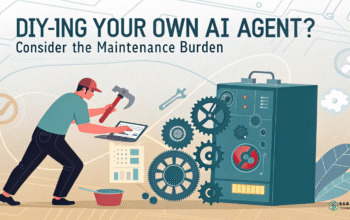Master the best practices for Salesforce DevOps to accelerate deployments and minimize errors.
In the ever-shifting digital arena, Salesforce developers are increasingly leaning on Salesforce DevOps practices to streamline deployment cycles, boost collaboration, and reduce bugs. As we navigate through 2025, the evolution of DevOps in the Salesforce ecosystem is impossible to ignore. With heightened expectations and tighter delivery timelines, it’s not just about pushing code, it’s about doing it smartly, swiftly, and securely.
Why Salesforce DevOps is Non-Negotiable in 2025
DevOps is no longer just a trend; in fact, it has become an absolute necessity. Since the Salesforce platform is rich in features but also quite complex in structure, it naturally demands an approach that not only reduces human error but also supports faster iteration. That’s exactly where Salesforce DevOps practices come in. They provide the crucial edge teams need by making it easier to manage metadata, test changes thoroughly, and deploy across environments all without the usual headaches and friction. In other words, adopting these practices helps your team work smarter, not harder.
1. Embrace Continuous Integration Like a Pro
One of the cornerstones of modern DevOps is continuous integration. Every code commit automatically triggers tests and merges, which reduces integration issues later in the pipeline.
Using CI tools tailored for Salesforce like Jenkins, GitHub Actions, or Bitbucket Pipelines helps enforce clean coding standards. More importantly, it empowers teams to receive feedback early, saving both time and budget in the long run.
Pro Tip: Automate your Apex test runs and static code analysis to catch issues before they snowball.
2. Salesforce DevOps and Version Control: Your Deployment Safety Net
Although some Salesforce developers still rely on change sets, version control systems (VCS) like Git are a game-changer. By using a proper branching strategy, teams can isolate development, hotfixes, and releases with precision.
Incorporating Salesforce DevOps tools such as Gearset or Copado makes integrating with VCS easier. This isn’t just about safety; it’s about working smarter.
3. Automate Deployments with a Human Touch
Automation doesn’t mean removing the human element. Instead, it’s about reducing repetitive work so developers can focus on meaningful tasks. Deployment automation ensures changes are promoted consistently across environments, reducing manual errors.
Always verify deployments in a sandbox first, and never underestimate the power of a pre-deployment checklist.
4. Monitor, Measure, and Improve
What doesn’t get measured simply doesn’t improve. Therefore, a high-functioning Salesforce DevOps team constantly reviews key metrics such as deployment frequency, lead time for changes, change failure rate, and time to restore. By regularly monitoring these indicators, teams can identify bottlenecks and, consequently, make informed decisions. As a result, continuous improvement becomes achievable, leading to smoother and more efficient deployments over time.
By tracking these indicators, teams can refine processes, spot bottlenecks, and uncover hidden opportunities for optimization.
5. Foster a DevOps Culture, Not Just Tools
Tools are helpful, but culture drives transformation. Encourage open communication, regular retrospectives, and knowledge sharing. This people-first approach ensures that DevOps becomes a mindset, not just a methodology.
Also, invest in training continuous learning is essential for staying ahead in the Salesforce world.
6. Salesforce DevOps Backup and Rollback Essentials
It’s easy to overlook backup strategies when things are running smoothly. However, smart Salesforce DevOps teams always prepare for the unexpected. Incorporate regular data and metadata backups, and ensure rollback plans are tested and documented. You won’t need them until you do.
7. Test Early, Test Often
Automated testing is not a luxury, it’s a prerequisite. Integrate unit tests, integration tests, and UI tests into your CI pipeline. This practice reduces the chances of introducing breaking changes, especially when multiple developers contribute simultaneously.
Using tools like Provar or Selenium can bring much-needed clarity to the QA process.
Salesforce DevOps in 2025
To thrive in 2025, Salesforce developers must first embrace a forward-thinking Salesforce DevOps strategy. Indeed, it’s not just about tools; rather, it’s about building a reliable, adaptive, and agile delivery ecosystem. From version control and continuous integration to thorough testing and cultural alignment, every piece plays a critical role. Moreover, by integrating these elements effectively, teams can accelerate deployments while minimizing risks and errors. Ultimately, success depends on how well all these factors work together seamlessly.
By investing in these best practices today, you’re setting up your team to deliver faster, safer, and more confidently tomorrow.
FAQs
1. What is Salesforce DevOps?
Salesforce DevOps is a set of practices that combine software development and IT operations to streamline code deployment, improve collaboration, and minimize errors within Salesforce environments.
2. Why should Salesforce developers care about continuous integration?
Continuous integration helps identify bugs early by automatically testing code changes, thus reducing the risk of failed deployments.
3. Are there tools specifically built for Salesforce DevOps?
Yes, tools like Gearset, Copado, AutoRABIT, and Blue Canvas are tailored for Salesforce DevOps workflows, offering solutions for version control, CI/CD, and deployment automation.
4. Can DevOps be adopted without coding knowledge?
While some understanding of code is beneficial, many Salesforce DevOps tools offer low-code interfaces to make the process accessible for admins and non-developers.
5. How often should Salesforce backups be scheduled?
It’s best to perform metadata backups daily and data backups weekly, depending on the volume of changes and the criticality of the data.
Feeling more like puzzles than solutions? That’s when Sababa steps in.
At Sababa Technologies, we’re not just consultants, we’re your tech-savvy sidekicks. Whether you’re wrestling with CRM chaos, dreaming of seamless automations, or just need a friendly expert to point you in the right direction… we’ve got your back.
Let’s turn your moments into “Aha, that’s genius!”
Chat with our team or shoot us a note at support@sababatechnologies.com. No robots, no jargon, No sales pitches —just real humans, smart solutions and high-fives.
P.S. First coffee’s on us if you mention this blog post!



